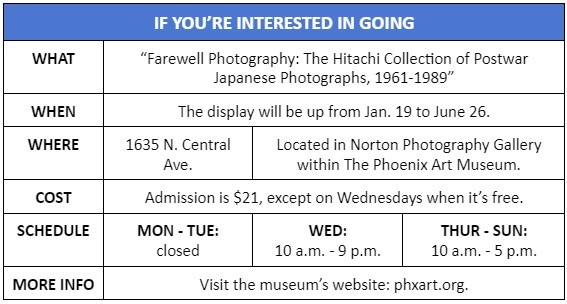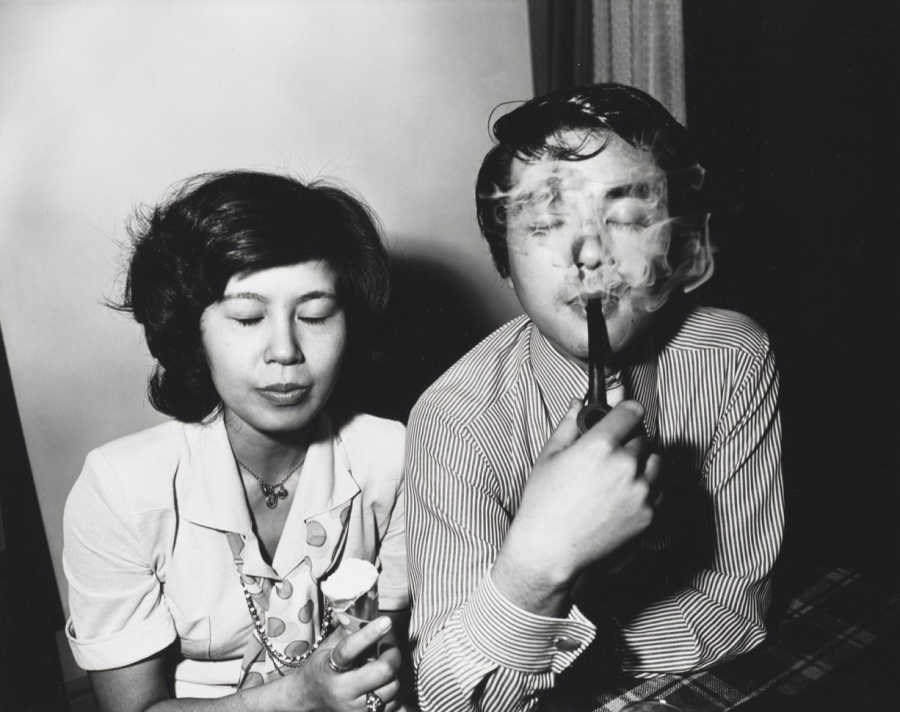The University of Arizona Center for Creative Photography, as part of its landmark collaboration with the Phoenix Art Museum, brings a never-before-seen glimpse of the way post-World War II Japanese photographers tried to counter the propaganda from their government.
With 87 photographs curated over many years, the Phoenix Art Museum is hosting the exhibit “Farewell Photography: The Hitachi Collection of Postwar Japanese Photographs, 1961 to 1989” until mid-summer.
Dr. Audrey Sands, the Norton Family Assistant Curator of Photography, spoke about the upcoming exhibit.
“We have a responsibility as a cultural institution to reflect back the amazing diversity of our audiences,” Dr. Sands said.
The Hitachi Collection is one of three annual photography exhibits put on by the Phoenix Art Museum, drawing from the CCP’s unrivaled collection of historical and contemporary photography.
The Hitachi images by post-World War II Japanese photographers attempt to change the narrative their country put out after the war. In one image, a flock of birds sits on a tree, as three elderly men stand in front of a gate, a couple closes their eyes as they smoke with a silhouette of a man walking down a hallway.
“These photographers were pushing against traditional practices and what was traditionally accepted by the art world, photography world and government sanctioned practices,” Sands said. “They inspired a whole generation of artists. I think that’s a real lesson: to think outside the boundaries that you inherit.”
The exhibition’s origins began in 1988 as the CCP set out to acquire work by contemporary photographers of post-World War II Japan through grants by the Hitachi Corporation. After retrieving these photographs, the UA center collaborated with the Phoenix Art Museum to showcase the collection in the state of Arizona.
Sands said she hopes the exhibit will broaden and challenge the worldview and perspectives of visitors in the Southwestern U.S. Being a part of the team that brought both the CCP and Phoenix Art Museum together for the exhibit, it was important to present the parallels of postwar Japan and the present day.
The postwar government in Japan quickly utilized the medium of photography as a tool for propaganda. The government’s documentary style sent a message to Japanese citizens that what they were seeing was the only truth they needed to consider.
“These photographers wanted to say that all photography is a manipulation and a distortion,” Sands said.
RELATED: The Center for Creative Photography introduces digital viewing during the pandemic
The Japanese were also dealing with the aftermath of American military occupation and the influx of Western culture that was impacting and contorting Japanese culture to the point where these photographers were asking themselves “What is national identity?”
The photograph “New Couple Who Closed Their Eyes, Tokyo,” showing a couple caught mid-snapshot together, eyes closed, smoking, is an example of distancing from the expected complacency and showcasing a new approach to photography.
“It symbolizes this moment in photography, signaling a totally new approach to vision. It hints at a kind of otherworldliness and a refusal to meet eyes and suggests that photography can be a screen between two worlds. There is a kind of surrealism to that image,” Sands said.
Other photographic techniques that came from the resistance against government propaganda were shooting in higher angles and heightened contrast for the graininess for black and white photos. One of the biggest that is showcased in the exhibit is the are-bure-boke, translated to “rough, blurred, and out-of-focus”, which can be seen in the photograph “Ishikawamon, Kanazawa” as a group of crows perched themselves atop many branches with a faint light behind them.
“All exhibitions are the result of a lot of collaborative work among so many individuals throughout museums,” Sands said. “It wasn’t just my work that went into the show but the collective work of my many colleagues across CCP and Phoenix Art Museum.”

*El Inde Arizona is a news service of the University of Arizona School of Journalism.
Follow the Daily Wildcat on Twitter









